Finding home sweet home can be a tough sell
- December 14, 2015
- / Shannon Nickinson
- / economy
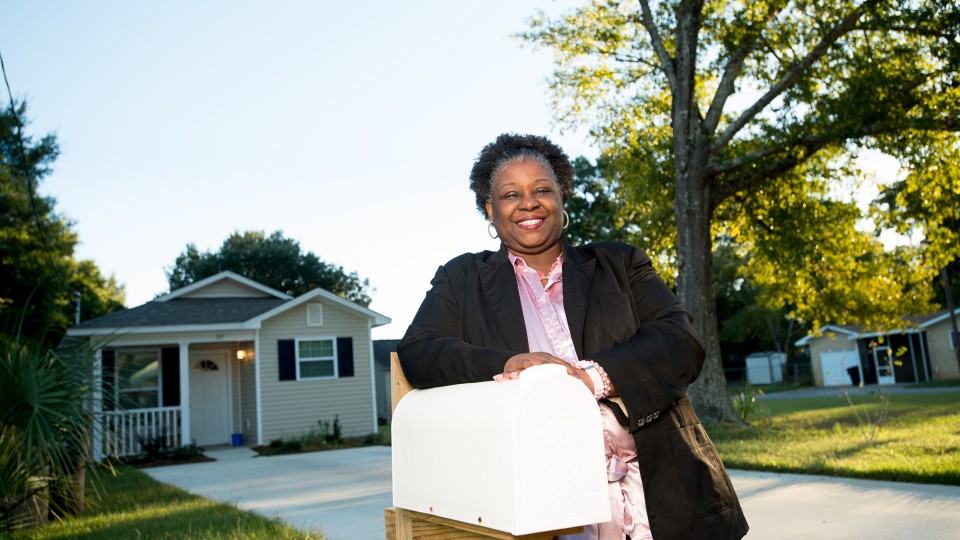
Sharon Nixon at her Habitat home in Pensacola Oct. 18, 2015.(Michael Spooneybarger/ Studer Community Institute)
The first night that Sharon Nixon spent in her home, every little noise woke her up.
“But then I could say, ‘I’m at my house. I’m not visiting anybody. I’m at my house,” said Nixon, the 46-year-old assistant manager at the Moorings Apartments.
Nixon’s home on East Lloyd Street came to her through the Habitat for Humanity program. The nonprofit seeks to build a community’s stock of safe, affordable housing. Homeowners have to work off a share of the cost through “sweat equity,” time they put into building the home.
Nixon found that she ultimately will save money by having a mortgage payment as opposed to paying rent — $659 a month in rent versus $550 a month for a mortgage payment.
The two-bedroom home — a rarity for Habitat, which typically builds three-bedroom or larger homes — is just what Nixon wanted.
“I love the area,” she says. It’s quiet, it’s a ‘neighborhood’ neighborhood area. That’s always what I wanted.”
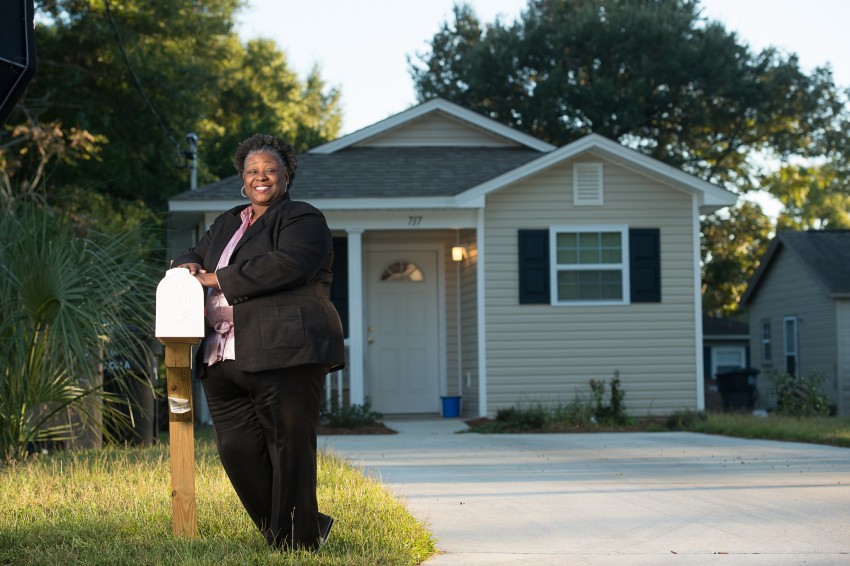
Sharon Nixon at her Habitat home in Pensacola Oct. 18, 2015.(Michael Spooneybarger/ Studer Community Institute)
While Nixon’s dream came true, her story may become rarer as availability of affordable housing lags the pace of the demand — nationally and in the Pensacola metro area.
At this year’s affordable housing summit, data indicated that the Pensacola area is 3,000 housing units short of the demand for affordable housing.
That scenario is unlikely to improve in a broad way anytime soon, according to research released Dec. 10 by the Harvard Joint Center for Housing Studies.
It found that the nnumber of people who are rent-burdened — paying more than 30 percent of their monthly income on rent — in America is higher than it’s ever been.
That metric is part of the Studer Community Institute’s Pensacola Metro Dashboard.
And it doesn’t bode well for our area. In Escambia County, 57.2 percent of people pay more than 30 percent of their monthly income on housing. In Santa Rosa County, it is 50 percent.
Even more concerning, according to SCI data: That figure has barely moved in five years.
With such a large percentage of income dedicated to covering the cost of putting a roof over our heads, consumers have less to spend on other things, including food, clothes, even other bills.
Low wages hurt Pensacola area
In June, Dr. Rick Harper, associate vice president at the University of West Florida and fellow at the Studer Community Institute, said the shortage of available units and low wages in the metro area were at the root of the issue.
“We have to raise the income of area residents,” Harper said then. “Tourism is only going to provide a sustainable wage unless it can build and sustain jobs year-round. You just can’t do that when you’ve only got a 10-week summer tourist season.”
While writing about the issue for the Washington Post, Emily Badger noted that it is economically tough for developers to build apartments at about $875 a month — the median renter’s price point.
Based on data from the Center for Housing Policy and Habitat for Humanity, fair market rent for a two-bedroom apartment in Pensacola is $830 a month.
To afford that, you need an annual salary of $33,200.
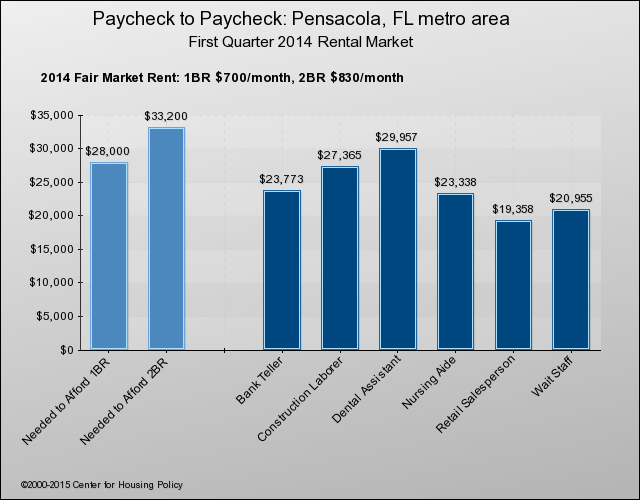
Data shows the annual salary needed to afford a one- or two-bedroom apartment in the Pensacola area — and the annual salaries of six typical jobs in the market. Source: Center for Housing Policy and Habitat for Humanity.
But as this chart shows, median wages for four of the five major job categories in Pensacola barely meet that level — especially for working women.

Median wages by industry for men and women in the Pensacola metro area. Source: American Community Survey
Apartments can be a tough sell
Even in Pensacola, affordable housing can be a tough sell.
In October, a planned $12 million to $15 million apartment project by a Georgia developer fell through for the Eastside neighborhood. Paces Foundation had planned to build apartments on North Hayne Street property they wanted to buy from Manna Food Pantries.
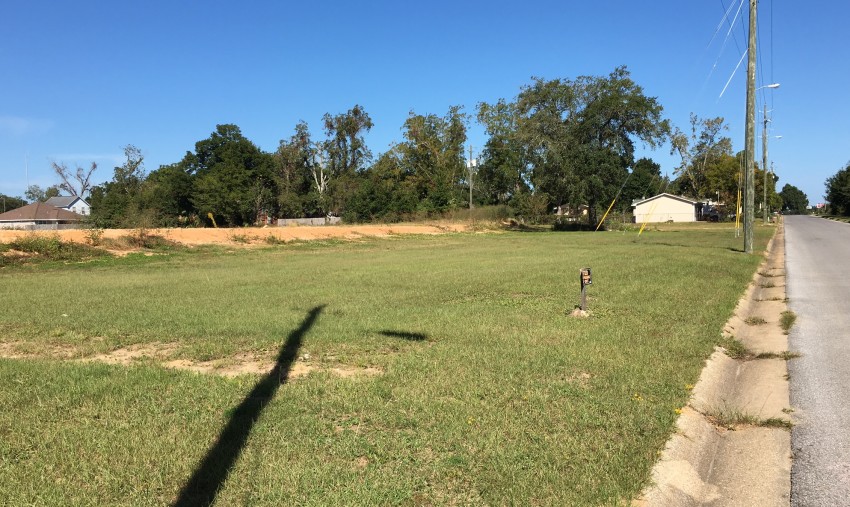
The former site of the J. Lee Pickens School on North Hayne Street remains on the market. Manna Food Pantries bought the property but abandoned plans to develop it as a warehouse and offices in the Eastside neighborhood. Photo credit: Shannon Nickinson
While the zoning now there would have allowed the development, planned changes in the zoning needed to comply with the land development code prevent apartment buildings.
The sale fell through as a result.
Several Eastside neighbors went to an Oct. 8 Pensacola City Council meeting to voice their opposition to granting a zoning variance that would have allowed the complex to be built because it didn’t fit with the redevelopment vision they have for the area.
Apartments were part of one of the top three respondents to proposals to develop the long-dormant Hawkshaw Property on Ninth Avenue near Gulf Power.
The other two respondents proposed condos amid mixed use retail space for the site.
All were rejected by the City Council, acting as the Community Redevelopment Agency, which opted instead to study possible uses for the city-owned property again.
Daily Convo LLC, a company of entrepreneurs Quint and Rishy Studer, is working to develop an apartment building at the site of the former Pensacola News Journal property at Romana and Jefferson streets.

Renderings for a possible apartment and mixed-use retail development at Jefferson and Romana streets in downtown Pensacola.
City and county officials recently approved an economic development ad valorem tax exemption (EDATE) for the project. The incentive means the property will continue to be taxed based on its current taxable value — for 2014 that’s $2,964,553 million — for 10 years.
The current tax paid on the land is $61,000. Based on the $50 million improvement value, the total annual taxes paid during 10-year EDATE would be approximately $539,300.
When the EDATE expires, the property can then be taxed at the full, post-investment value.
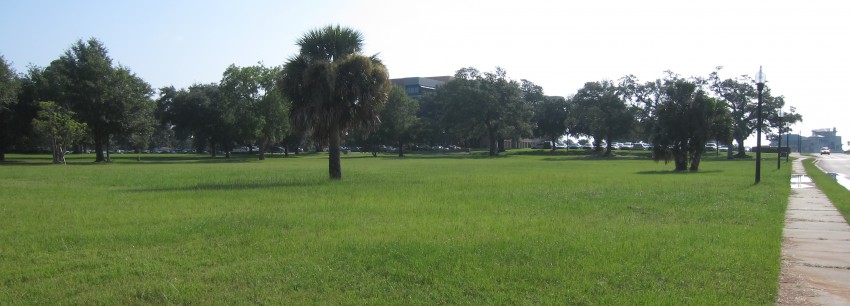
 CivicCon launches with a look at good growth in cities
CivicCon launches with a look at good growth in cities
 Building stronger brains one baby, one parent at a time
Building stronger brains one baby, one parent at a time
 SCI debuts commercial on Early Learning City
SCI debuts commercial on Early Learning City
 Entrecon: World class speakers and an opportunity to sharpen skills
Entrecon: World class speakers and an opportunity to sharpen skills
 PYP Quality of Life survey 2017
PYP Quality of Life survey 2017
 EntreCon Pensacola 2016: A look back
EntreCon Pensacola 2016: A look back
 Leadership tip: getting better employee takeaways
Leadership tip: getting better employee takeaways
 Leadership tip: be interested instead of interesting
Leadership tip: be interested instead of interesting
 Leadership tip: delivering difficult messages
Leadership tip: delivering difficult messages
 Brain Bags boost Arc, Early Childhood Court programs
Brain Bags boost Arc, Early Childhood Court programs